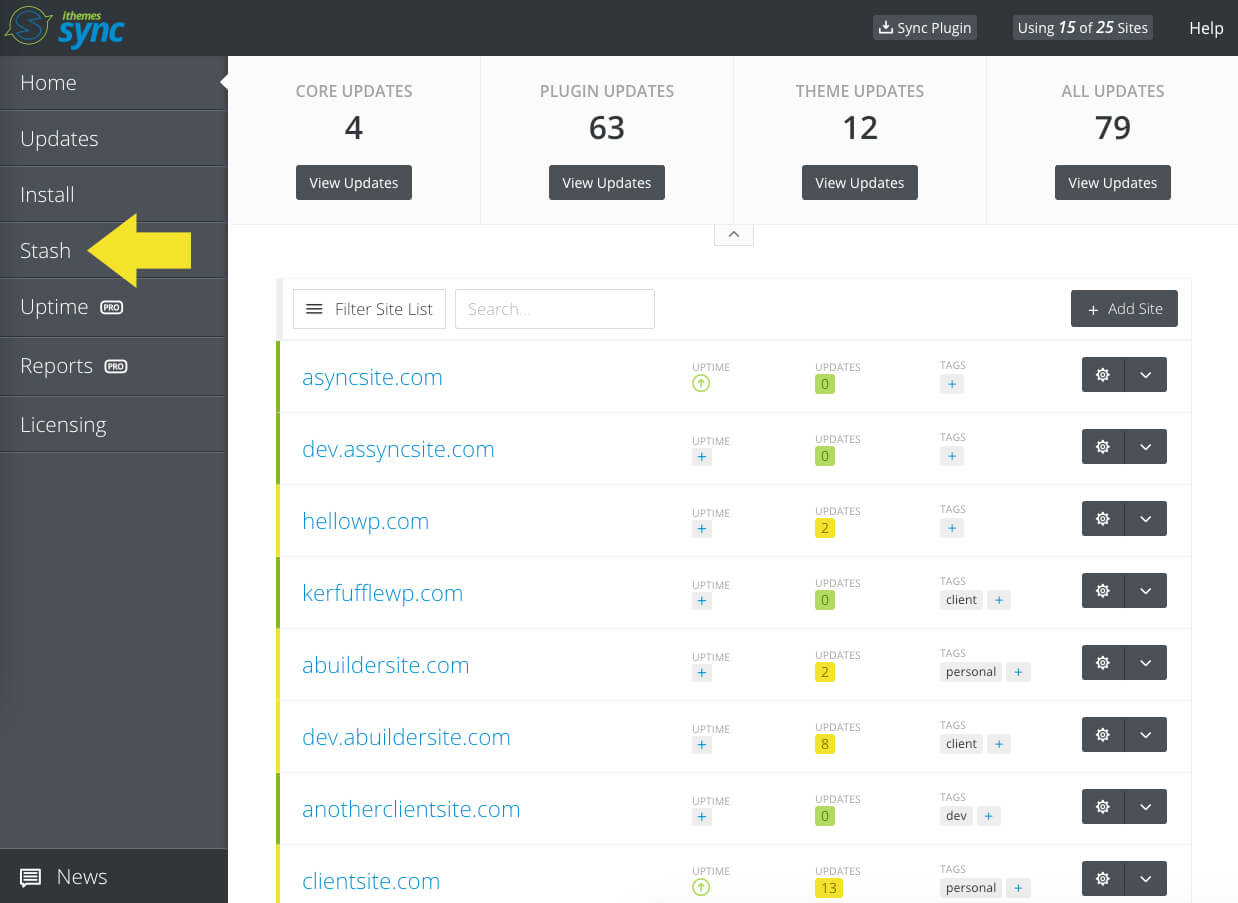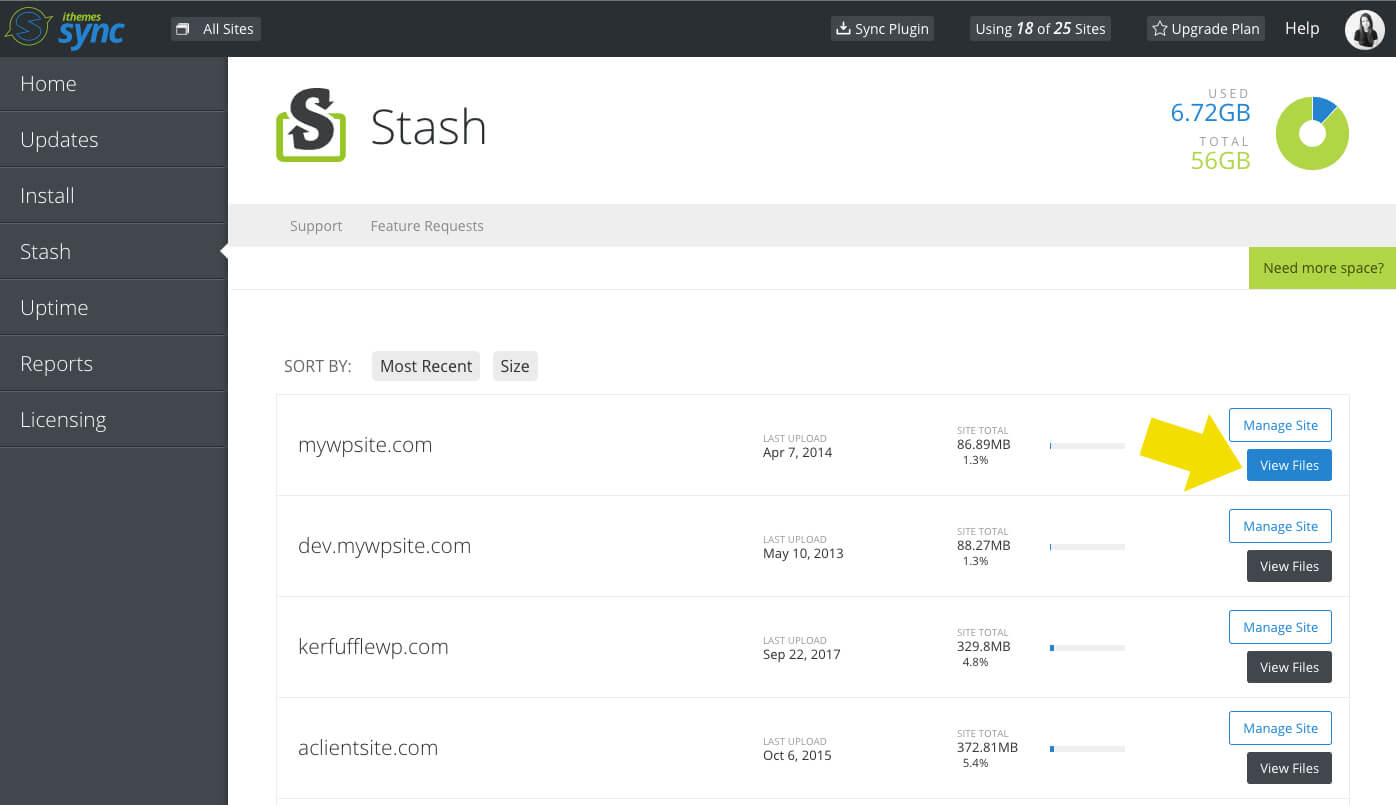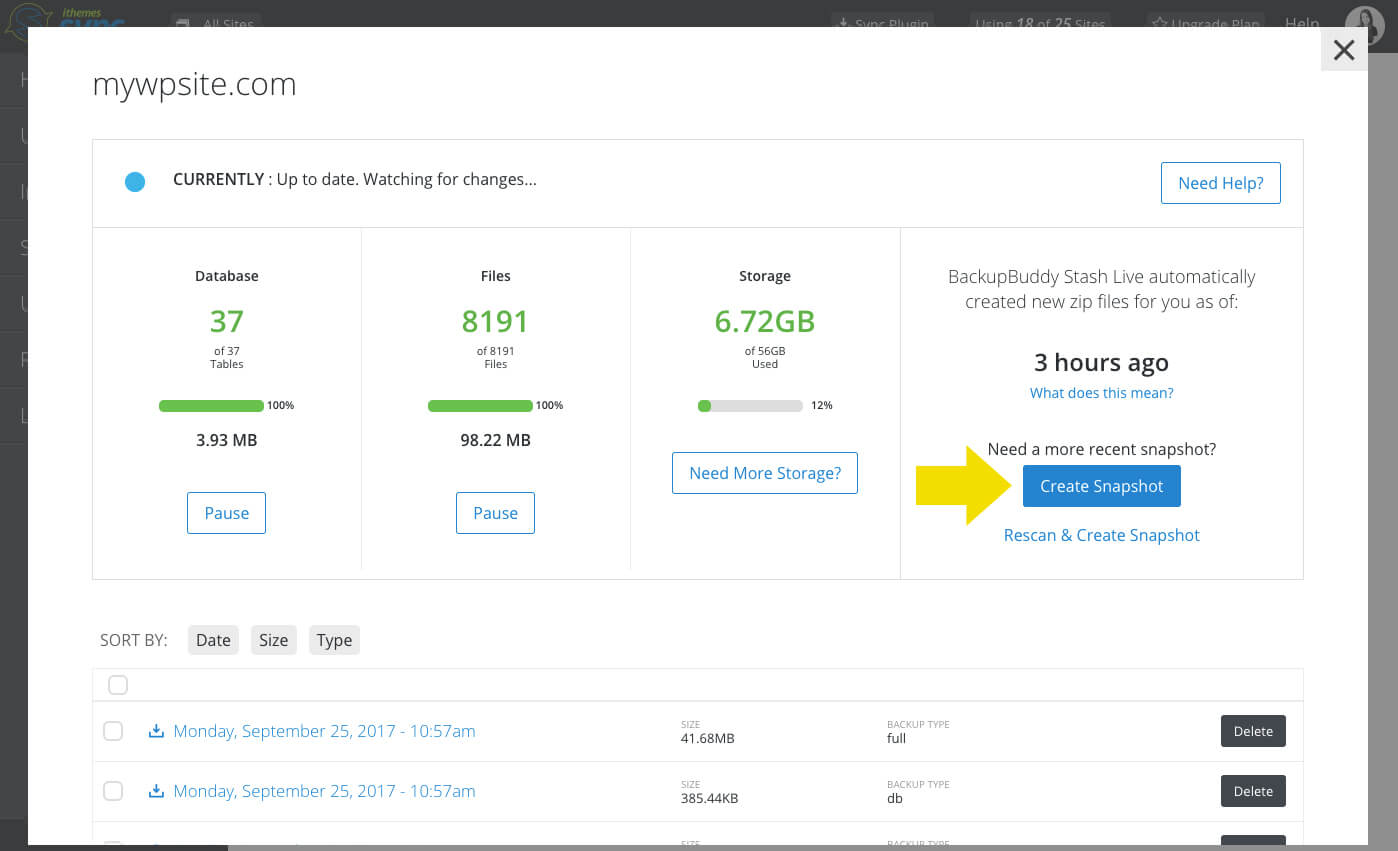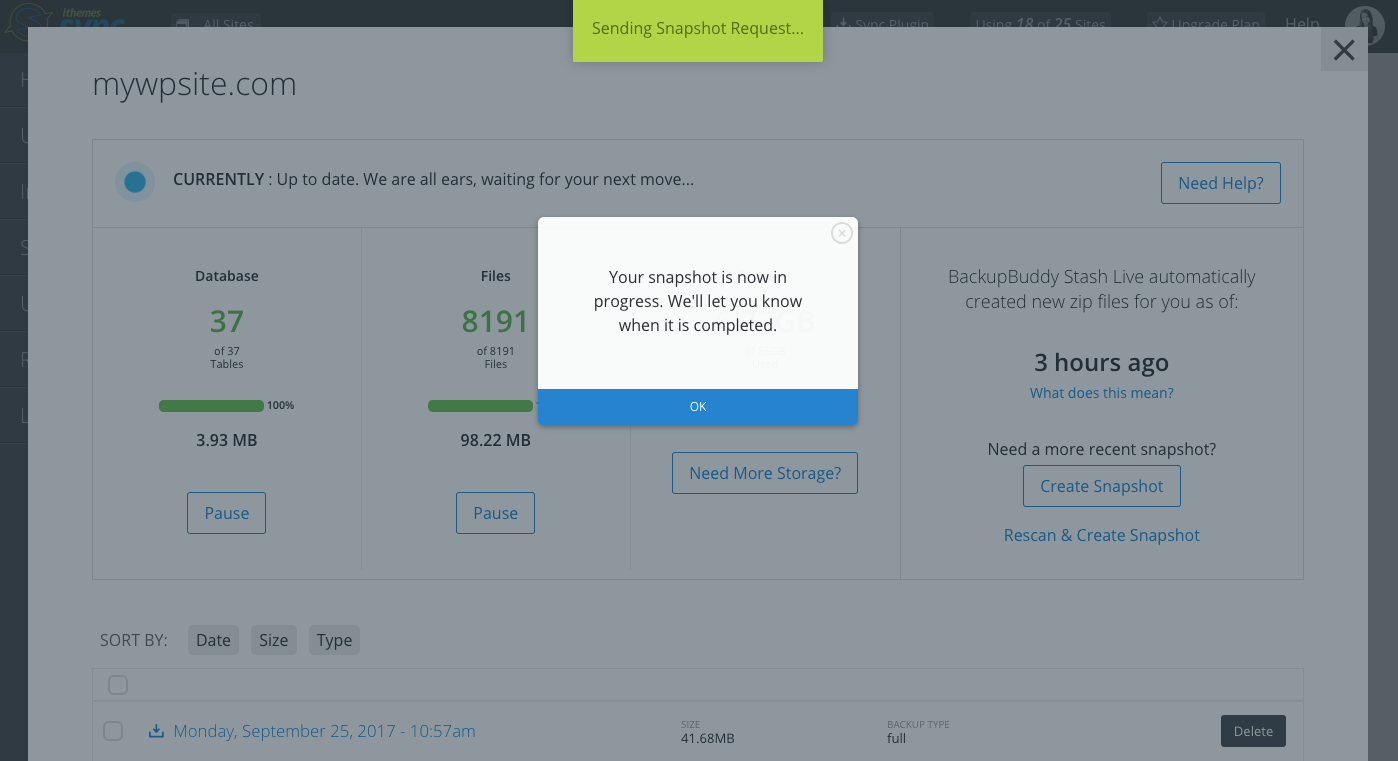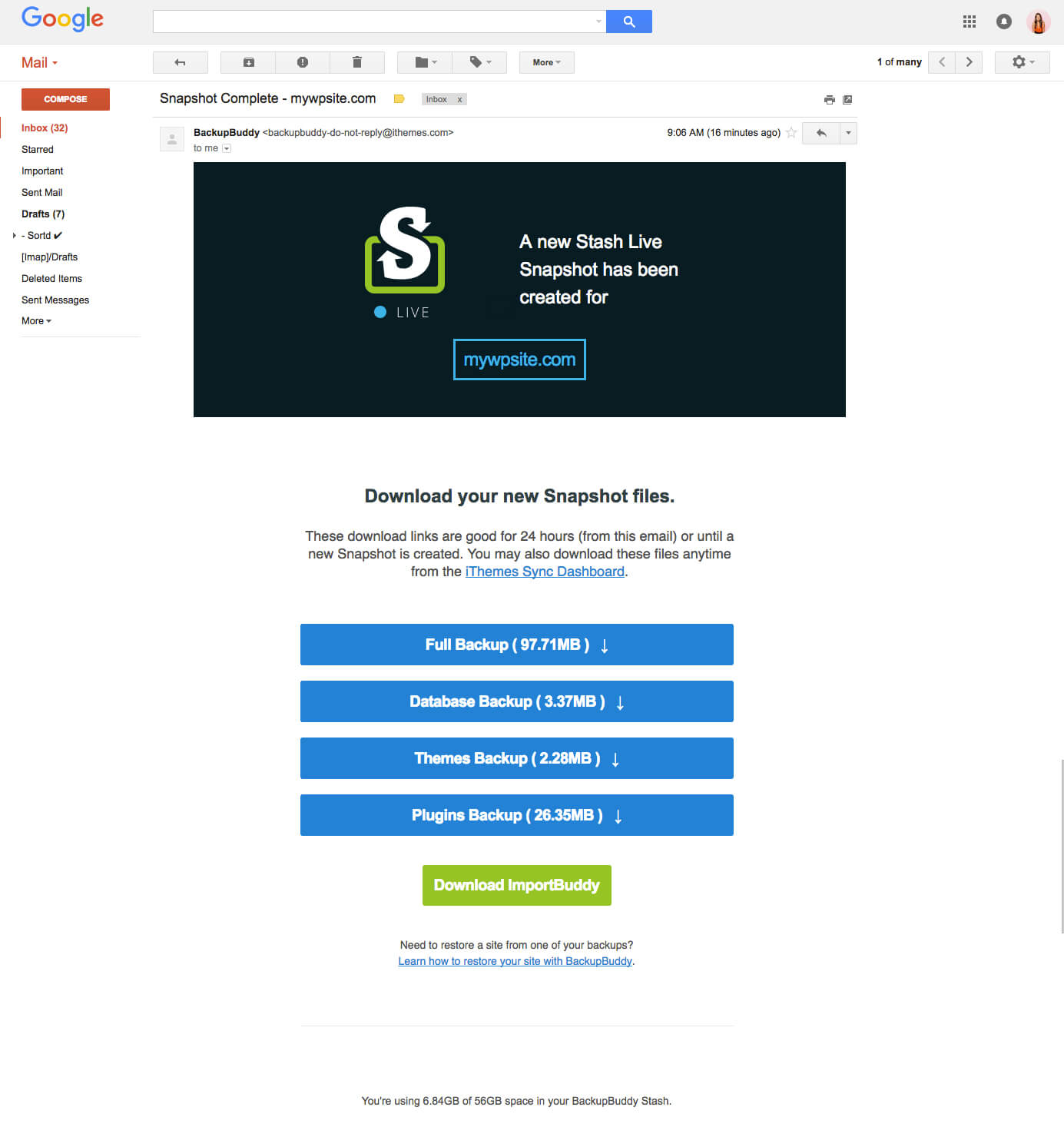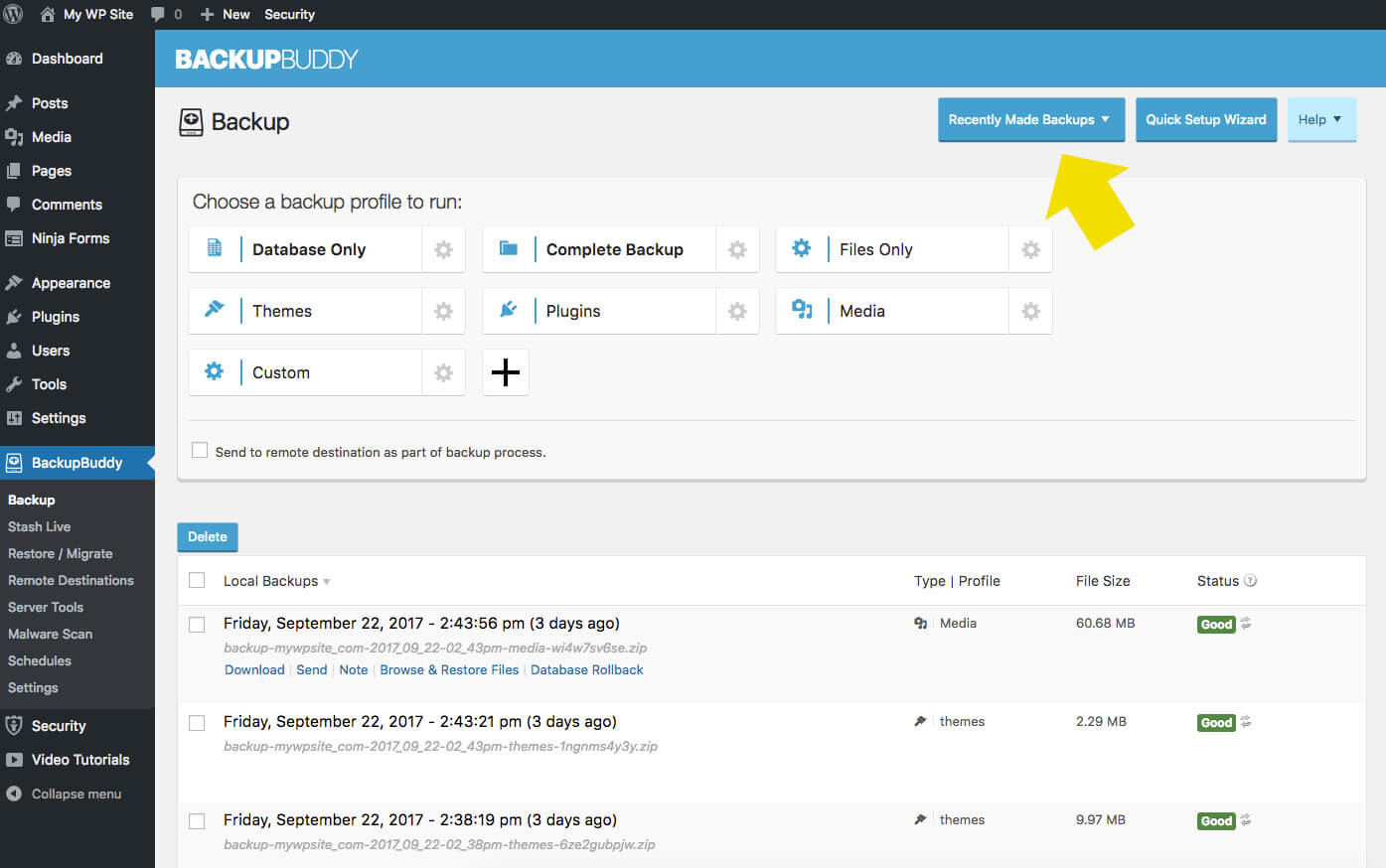9 Hidden BackupBuddy Features & Tips
BackupBuddy, the WordPress backup plugin, offers a ton of features beyond just handling your WordPress backups. In this post, we cover a few hidden BackupBuddy features you may not know about, so you can make sure you're taking full advantage of BackupBuddy's 3-in-1 WordPress backup, restore and migration functionality.

BackupBuddy, the WordPress backup plugin, offers a ton of features beyond just handling your WordPress backups. In this post, we cover a few hidden BackupBuddy features you may not know about, so you can make sure you’re taking full advantage of BackupBuddy’s 3-in-1 WordPress backup, restore and migration functionality.
1. Automatic Backups
BackupBuddy 8.0 introduced Stash Live, a automatic WordPress backup tool, included for free in the BackupBuddy plugin.
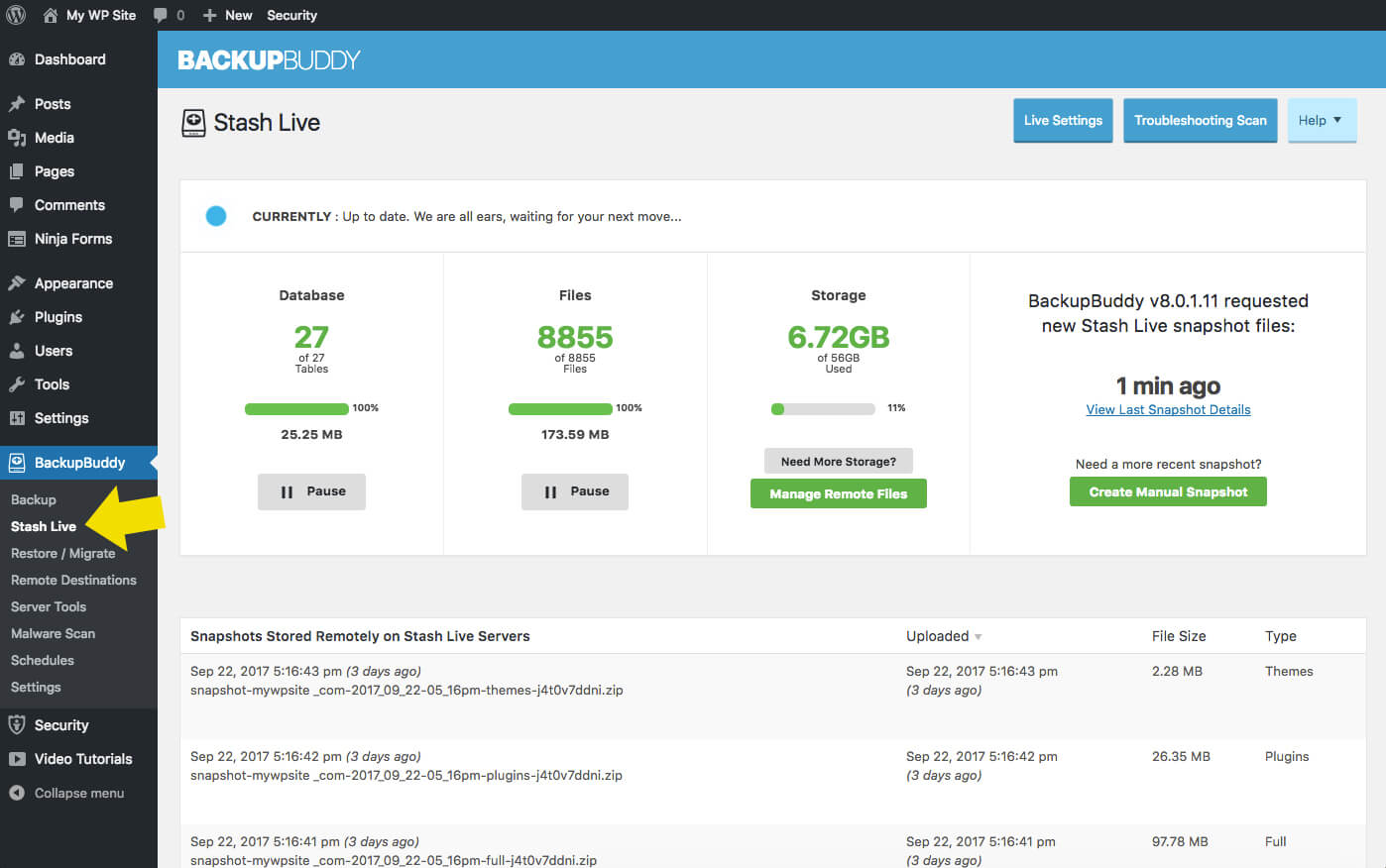
One of the key features of Stash Live is how it makes automatic backups.
In addition to daily Stash Live Snapshot (backup) zip files which are created automatically for you, Stash Live continuously mirrors live changes of your WordPress website to the cloud.
[pullquote]With Stash Live, you can generate a Stash Live Snapshot of backup data, which allows you to retrieve a backup of changes made since the last daily Stash Live Snapshot (or backup) was created.[/pullquote]
Your Stash Live Snapshot (backup) files are managed from the Stash Page of the iThemes Sync Dashboard. If you’re a current BackupBuddy customer, you can log in to the Sync dashboard here using your iThemes username and password.
To create a Snapshot, do the following:
- 1. Navigate to the Stash page in your iThemes Sync dashboard.
- 2. Find your site in the listing on the Home page, and click the View Files button to the right of it.
- 3. In the next screen, click the Create Snapshot button to create a new snapshot of the latest backup data from your website.
- 4. The new snapshot process will begin. You may stay on the page for progress updates or wait to receive an email with download links for the Snapshot zip files.
- 5. Once the snapshot finishes, you’ll receive an email with the download (zip) files containing the latest database changes up to the last second, as well as recently-completed file uploads of media, plugin or theme file changes.
2. Backup Profiles Combined with Backup Schedules
BackupBuddy’s traditional backups include powerful Backup Profiles, but you may not be fully taking advantage of them to customize your WordPress backups. [pullquote]BackupBuddy’s Backup Profiles allow you to customize what files are backed up on a case-by-case basis so you can have greater customization and control of your backups.[/pullquote]
With BackupBuddy’s pre-built Backup Profiles you can create the following types of WordPress backups:
- Complete Backup – Backup up your complete WordPress website, including all files in the WordPress directory (WordPress core, your WordPress database, themes, plugins, comments, media library and more)
- Database Only Backup – Backup your WordPress database only
- Files Only Backup – Backup only the files on your WordPress website
- Themes Backup – Backup just your theme files
- Plugins Backup – Backup just your plugin files
- Media Library Backup – Backup your WordPress media library
- Custom Files Backup – Set up a custom backup for a specific directory or file, such as a specific theme or plugin
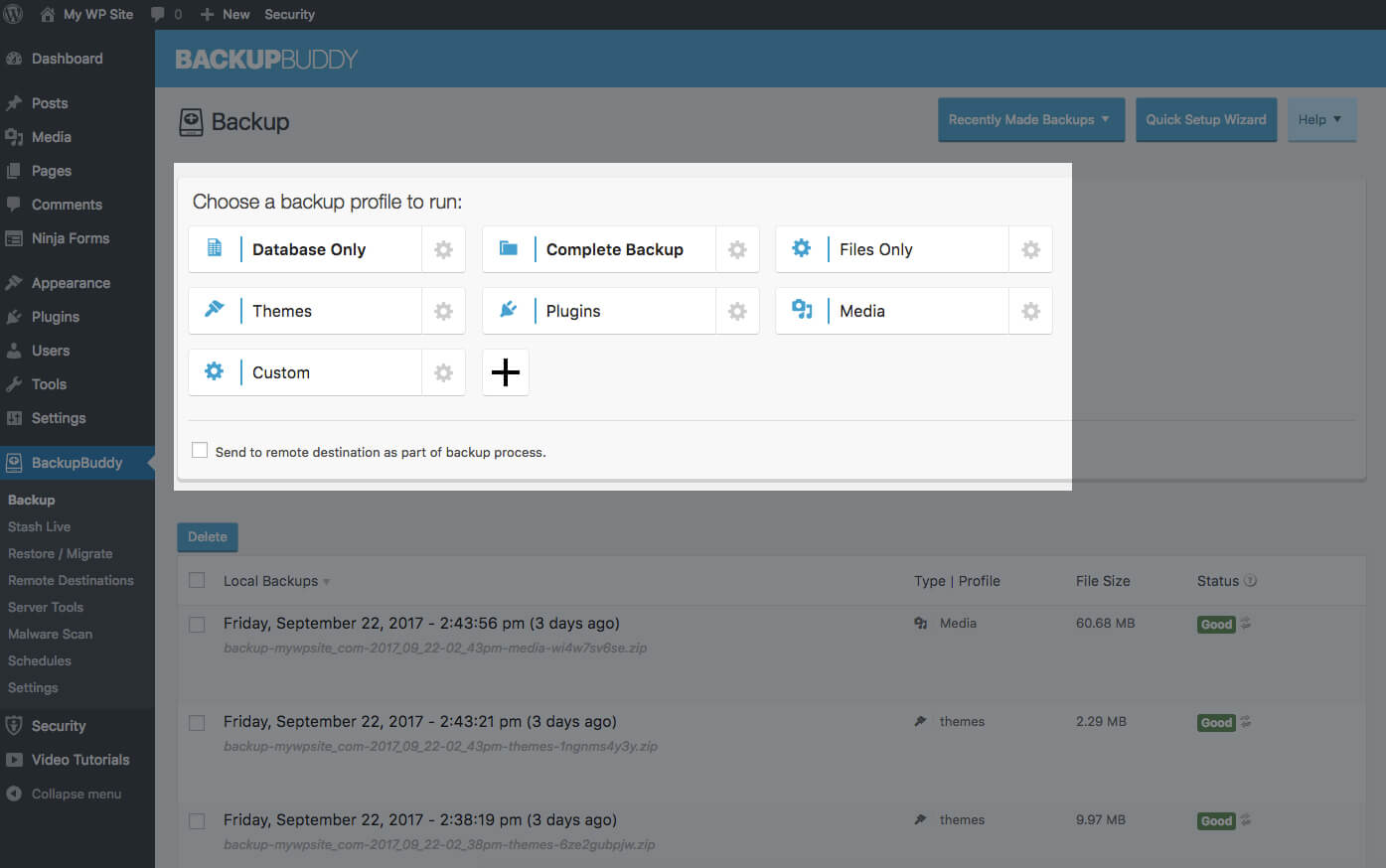
Combined with BackupBuddy’s backup Schedules, you can run these various types of backups at different intervals so you always have a backup of the different components of your site (as well as backups of the whole site). For example, you could back up a specific theme every hour if you’re currently making tweaks to your stylesheet on a development site.
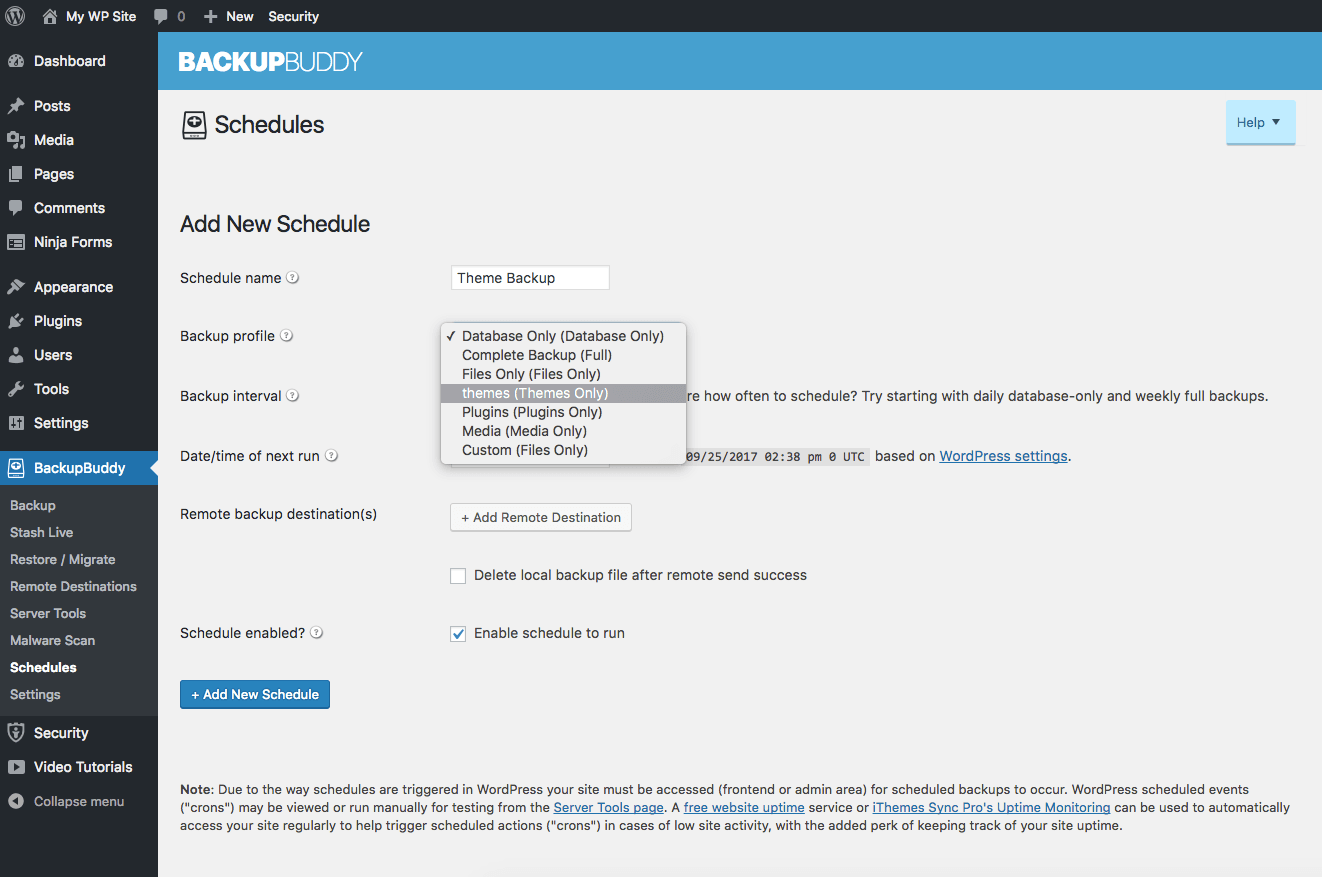
3. Export Various Parts of Your WordPress Site in A Downloadable Zip File
BackupBuddy backups are delivered as zip files you can download straight to your computer. Once you’ve unzipped the backup file, the contents contain all the files that make your WordPress site work (depending on the type of backup you created).
[pullquote]Using one of the Backup Profiles for Themes, Plugins or Media, you’re essentially exporting all the theme, plugin or media files from your website into a downloadable zip file.[/pullquote] For example, this could be helpful if you want to download all the images you’ve uploaded to your WordPress Media Library without having to download and save them one by one.
With BackupBuddy, you can export:
- Your Themes
- Your Plugins
- Your Media Library Files
- Your Entire WordPress Site
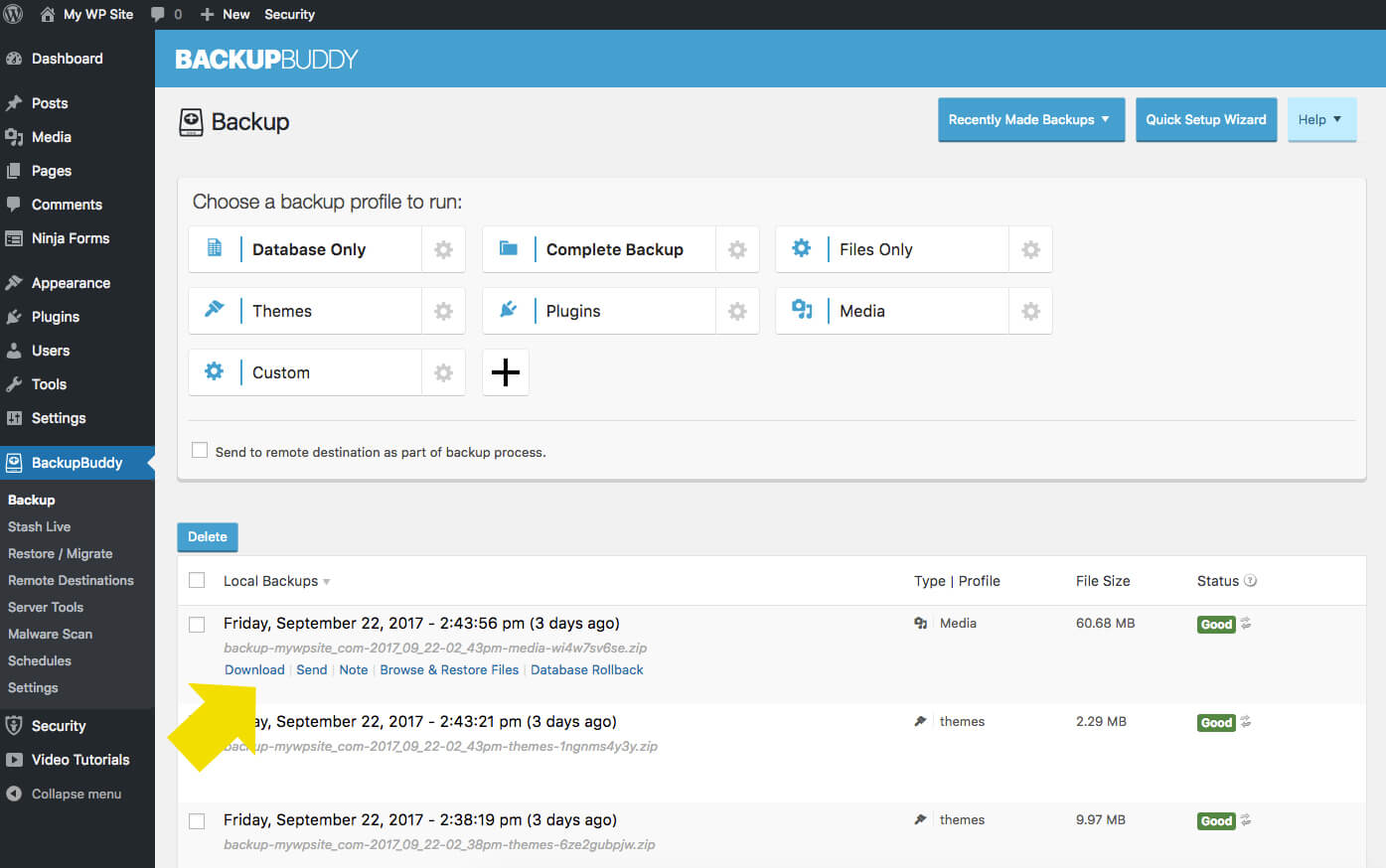
Once you unzip the zip file you download, you’ll have all the files contained in that backup (export).

4. View An Interactive Directory Size Map of Your Site
Another cool feature included in BackupBuddy is the Site Size Maps. With this tool, you can view an interactive graph of the sizes of various directories (or folders) on your WordPress site.
[pullquote]Site Size Maps make it incredibly useful to see where the most space is being taken up on your site.[/pullquote] So many users have no idea they have so much junk stored on their site, and sometimes it’s hard to find the stuff that is taking up space on your site/server. For example, if you notice your backups are larger than they should be, you can go to the Site Size Map and see where all the space is being taken up at (and then exclude it from your backups to reduce the size).
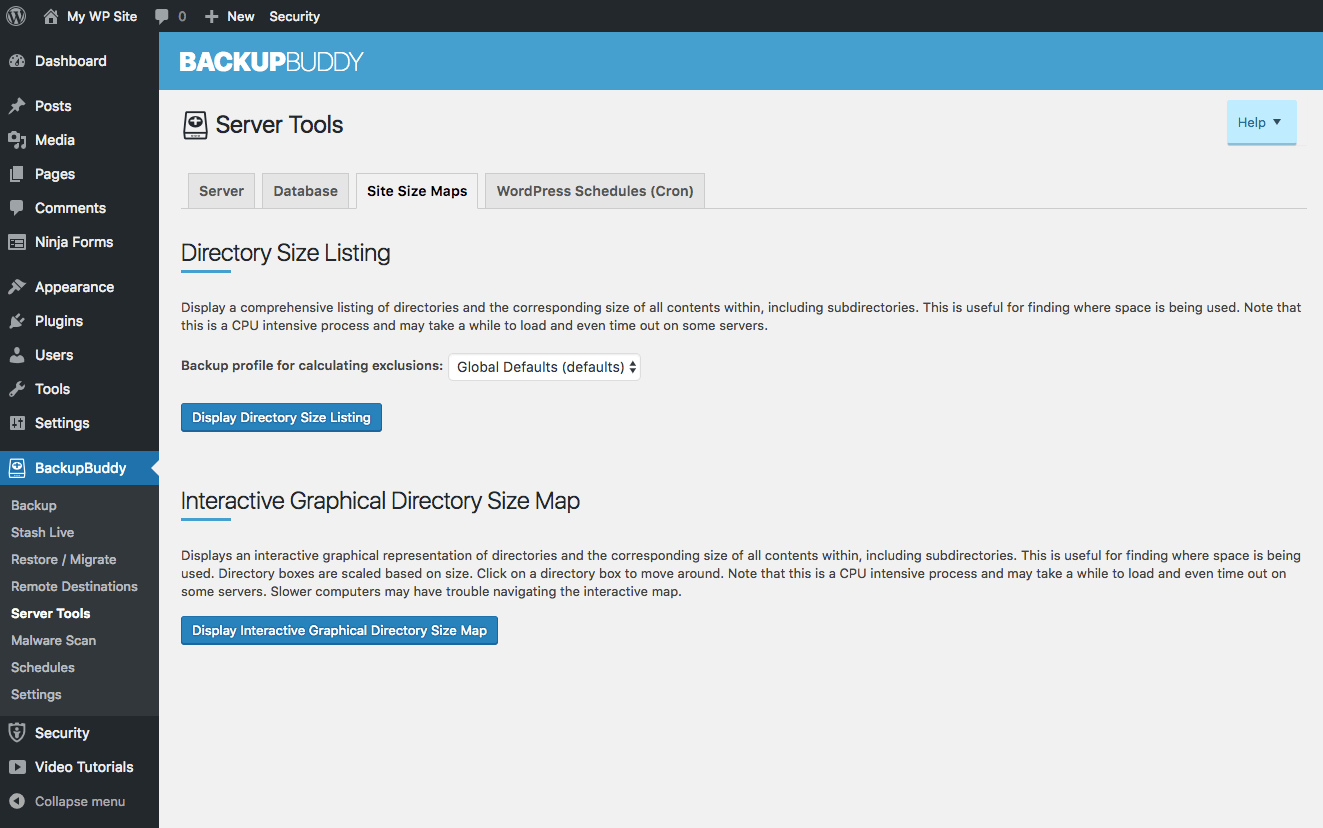
If you go to the Backupbuddy serer tools page, click the Site Size Maps. Then click the button Display Directory Size Listing. You’ll then see a list of all the directories that make up your website from largest to smallest, in descending order.
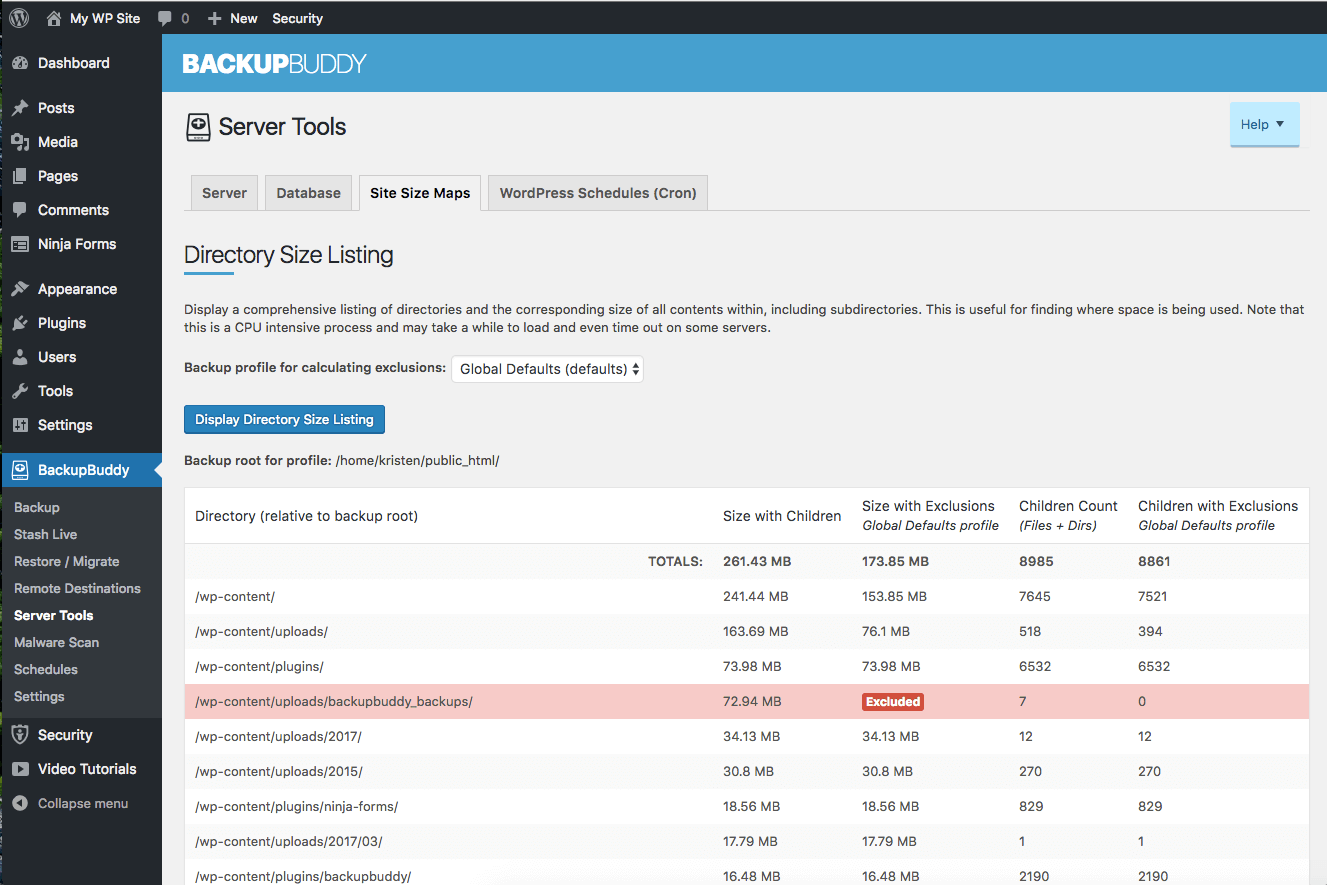
The directories you have excluded from your backups will be highlighted in red. This will show you the size of the site with exclusions and without. There’s also a drop-down above the list with all your Backup Profiles so this list will adjust based on which Backup Profile you select.
You can also view your directory size listing in an interactive graphical directory size map. BackupBuddy will show you a graphical representation of the directories and corresponding contents within, which is useful for seeing where space is being used.
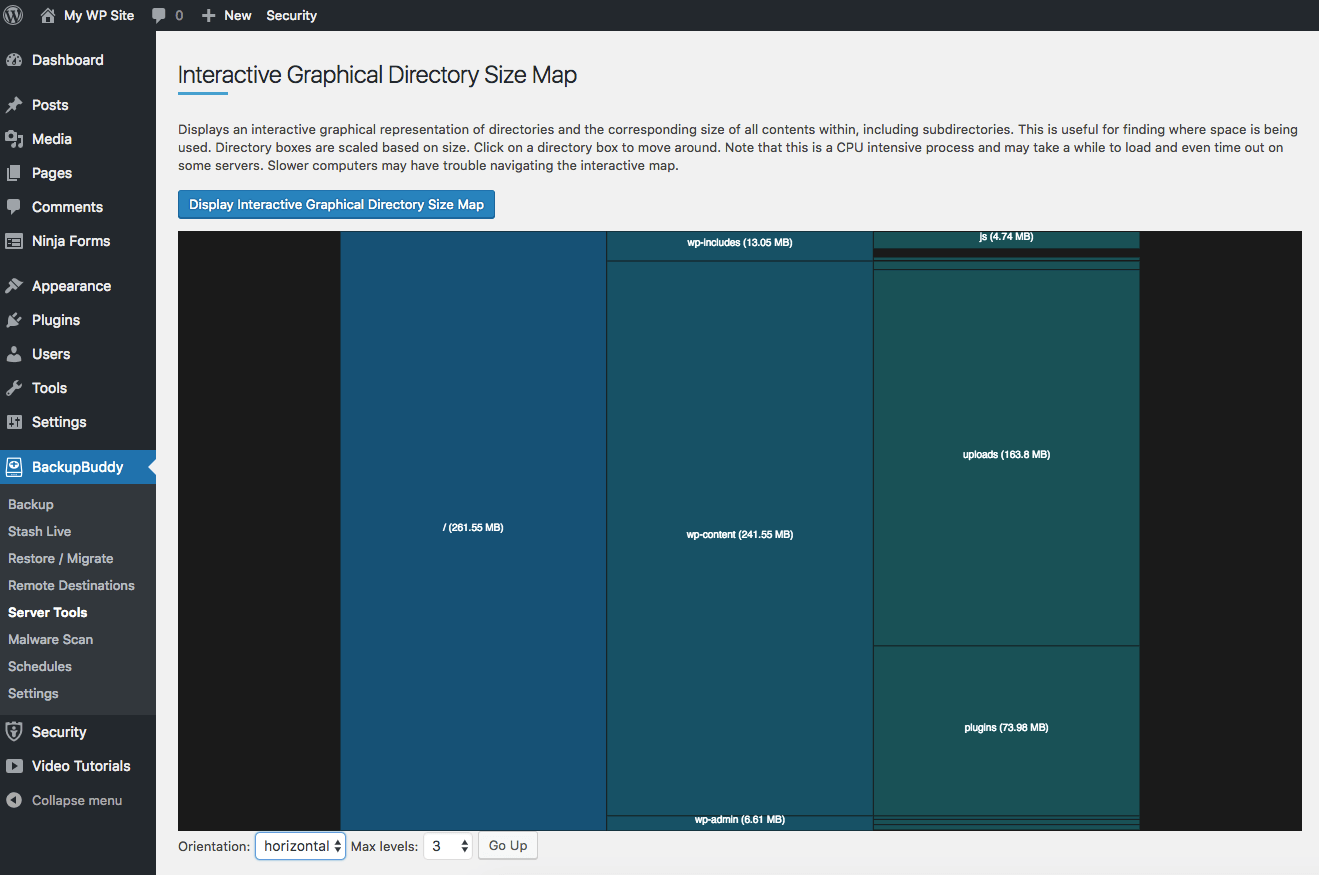
5. Utilize Local Backup Storage Limits
[pullquote]Enormous backup files are an issue many new BackupBuddy users face simply because they don’t know about local backup storage limits.[/pullquote] For example, if you run a complete backup of your WordPress site, and that backup file is stored on your WordPress site, the next time you run a backup, you just tripled the amount of data that your WordPress site is taking up on your server. So it is good to the keep those limits in place to keep the backups from piling up and hitting your disk quota.
Local Backup Storage Limits ensure that backup files don’t pile up, making your backup files too large.
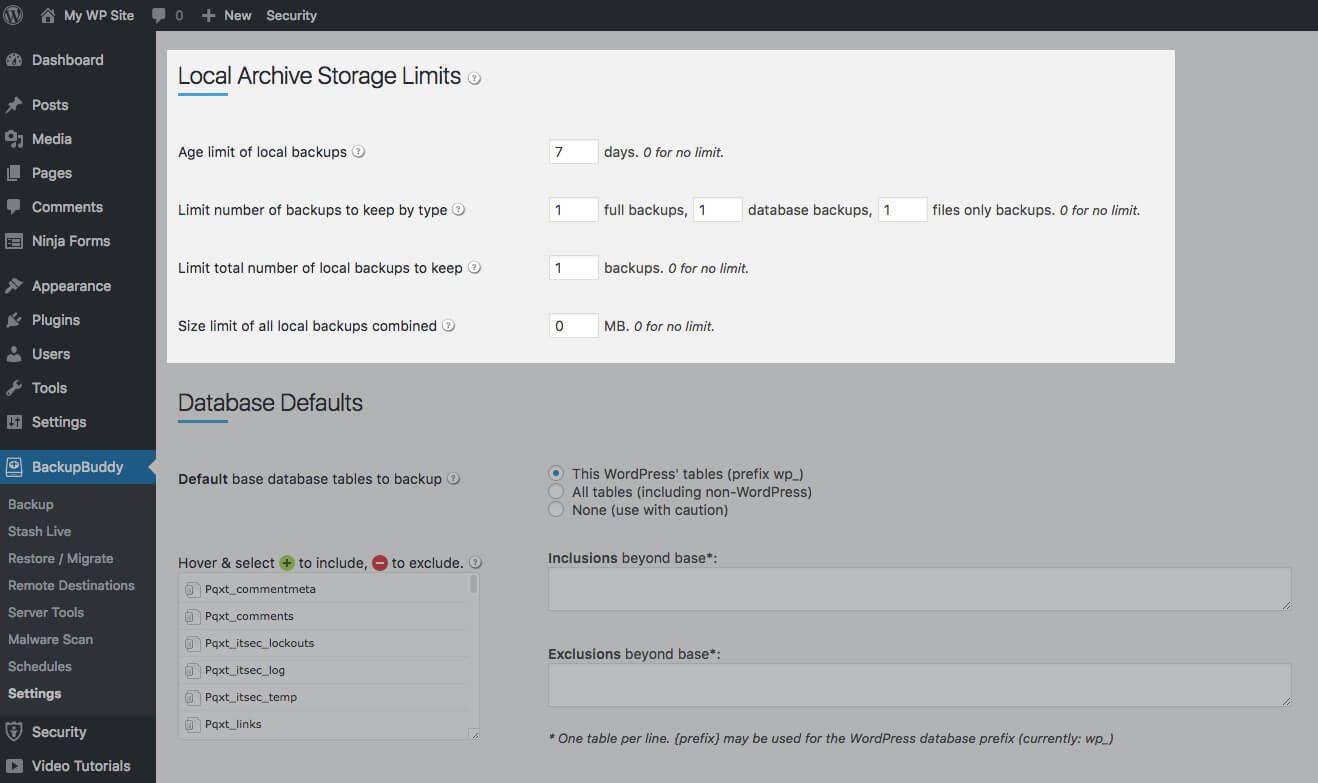
To check your local backup storage limits, visit the BackupBuddy > Settings page. These settings will differ depending on your needs and specific server configuration, but make sure to change the numbers here from “0” (no limit) to another value.
6. WordPress Server Tools
BackupBuddy includes some technical information about your server in the BackupBuddy > Server Tools page.
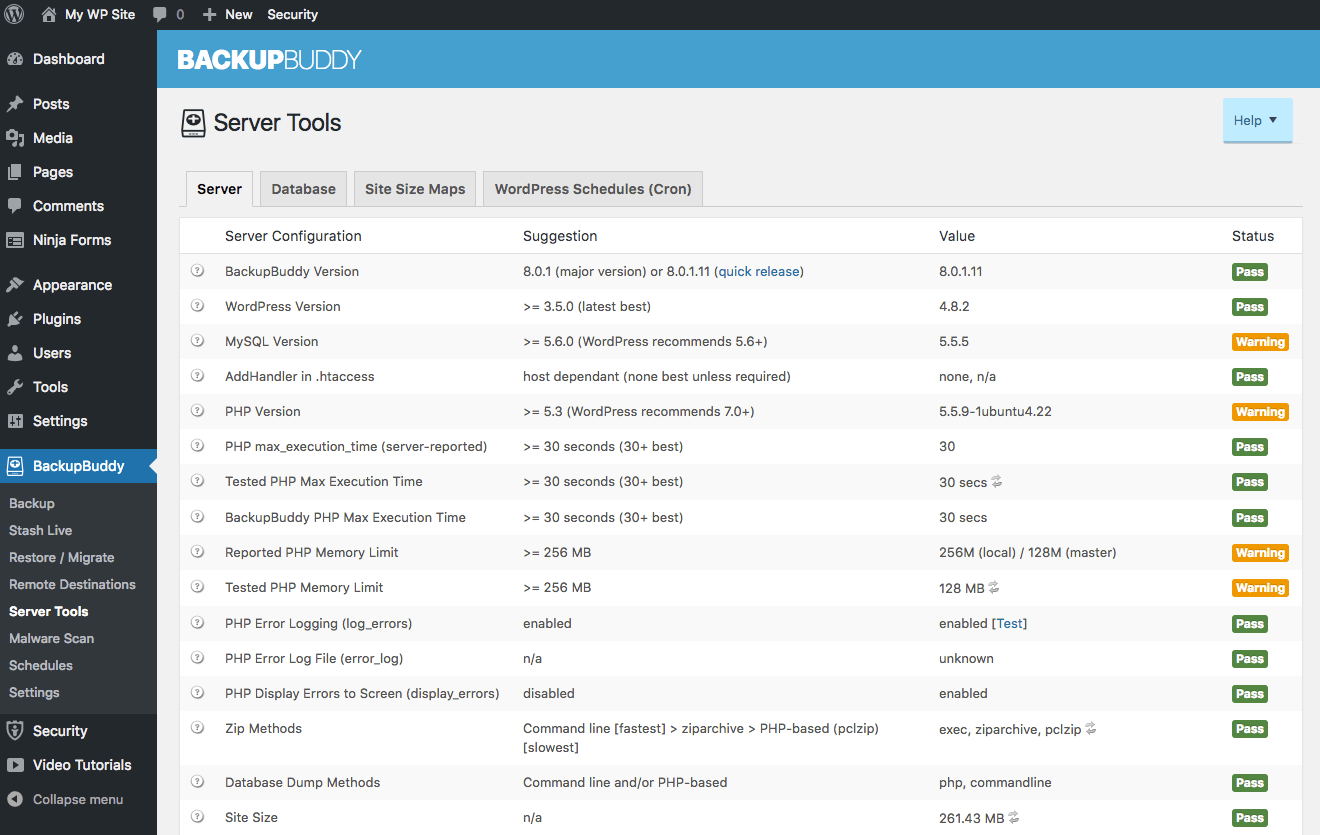
On the Server tab, you’ll see information about your server configuration with suggestions and a pass/warning status. This page is a quick way to find out things about your server, such as your PHP version, PHP memory limits, PHP execution time and more site-specific stats such as your site size, database size, etc. These values can impact your site performance or the type of software you can run on your website, such as some themes and plugins.
7. View A List of Recently Made Backups
If you need to view statuses of your recent backups, you can do so from the Recently Made Backups button on the BackupBuddy > Backup page.
You’ll then be able to see a listing of recent backups, including the date made, backup type, file size, trigger and status. Hover over the Status column to reveal links for more details and the backup log. The backup log is especially helpful for support if you ever have an issue with a backup.
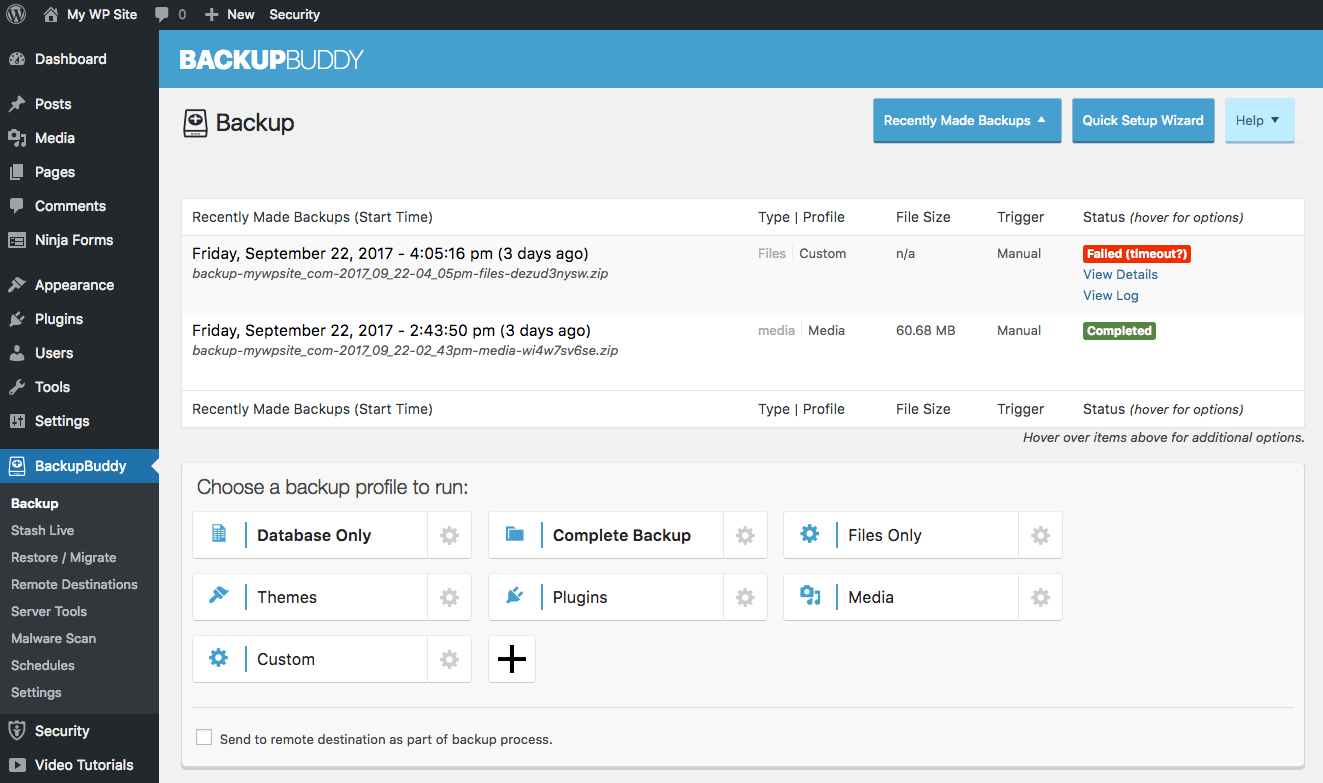
8. Customize or White-Label BackupBuddy Email Notifications
BackupBuddy includes several options for email notifications to keep you notified of your WordPress backups. From the BackupBuddy > Settings page, you can customize your email notification settings.
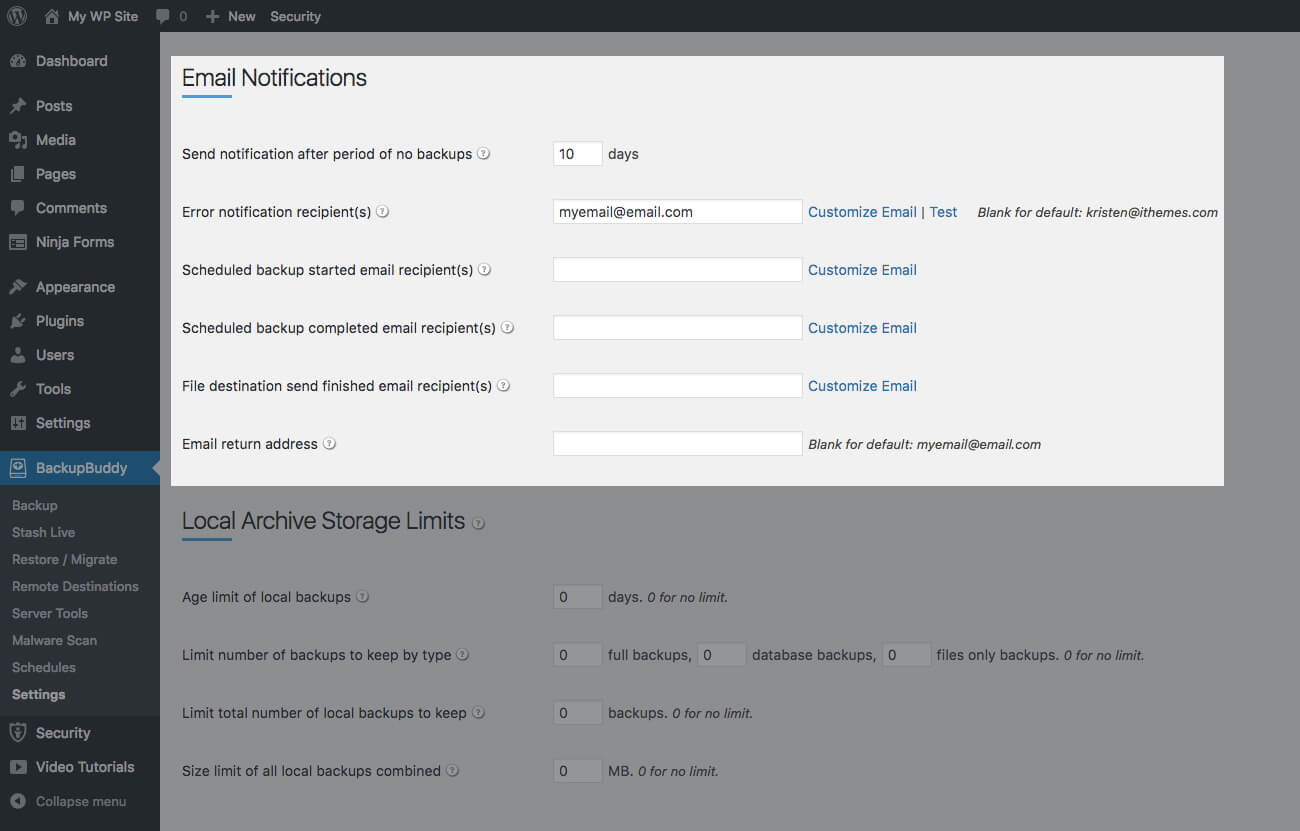
If you want to get fancy, you can even add HTML email templates. This might be helpful if you want to white-label emails for clients with your own branding.
To customize the HTML email template, copy the default template located at /wp-content/plugins/backupbuddy/views/backupbuddy-email-template.php into the theme directory at /wp-content/themes/backupbuddy-email-template.php. You can then edit this new file to your liking, and its existence will override the default BackupBuddy email templates.
9. Quick Setup Wizard
BackupBuddy includes a Quick Setup Wizard to help guide you through the initial setup of the plugin when you first install and activate it. You can access the Quick Setup Wizard anytime you want to review your settings from the BackupBuddy > Backup page.
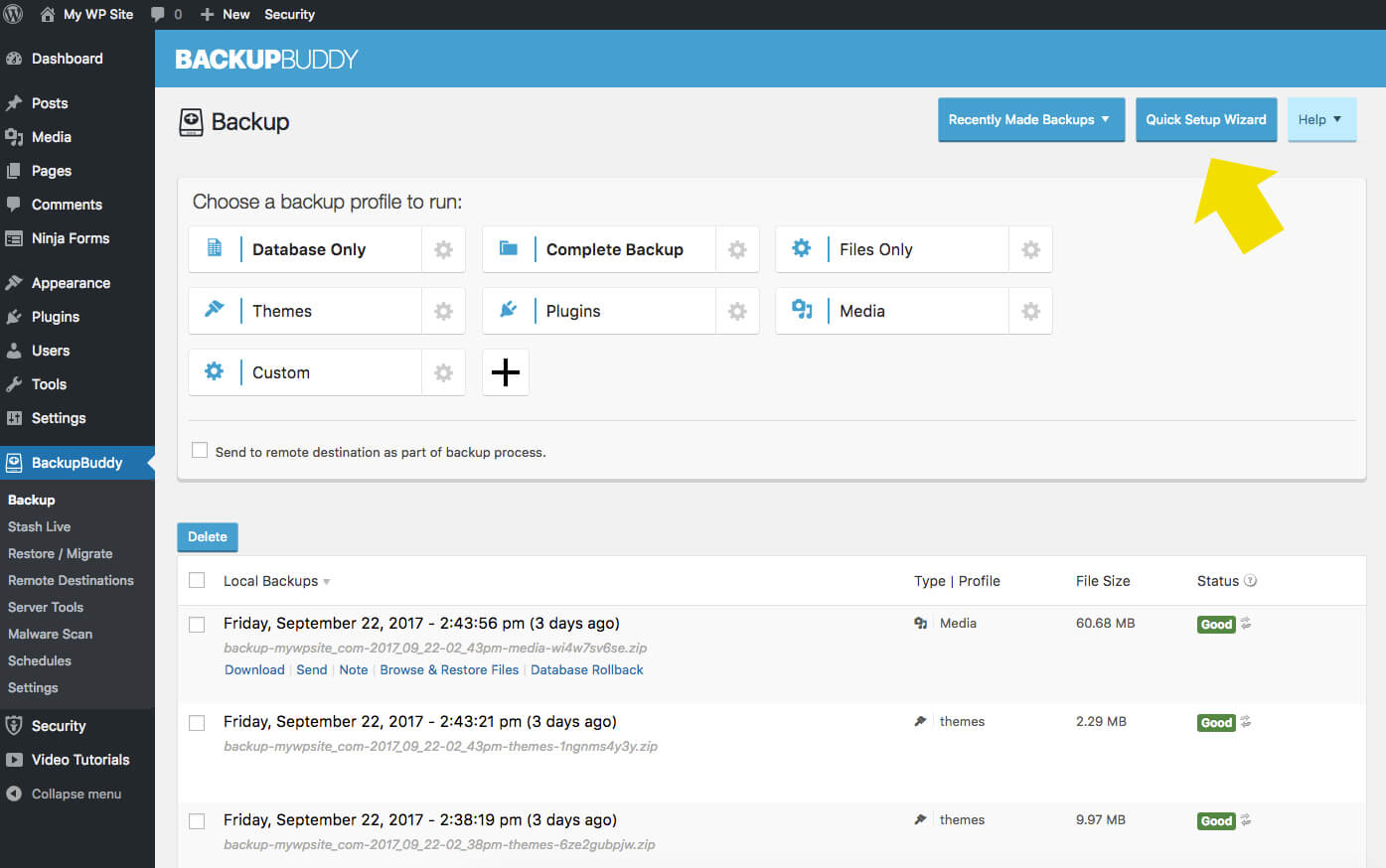
From this page, you can see an overview of the most important BackupBuddy settings, such as your ImportBuddy password, your remote destination of choice and a default backup schedule.
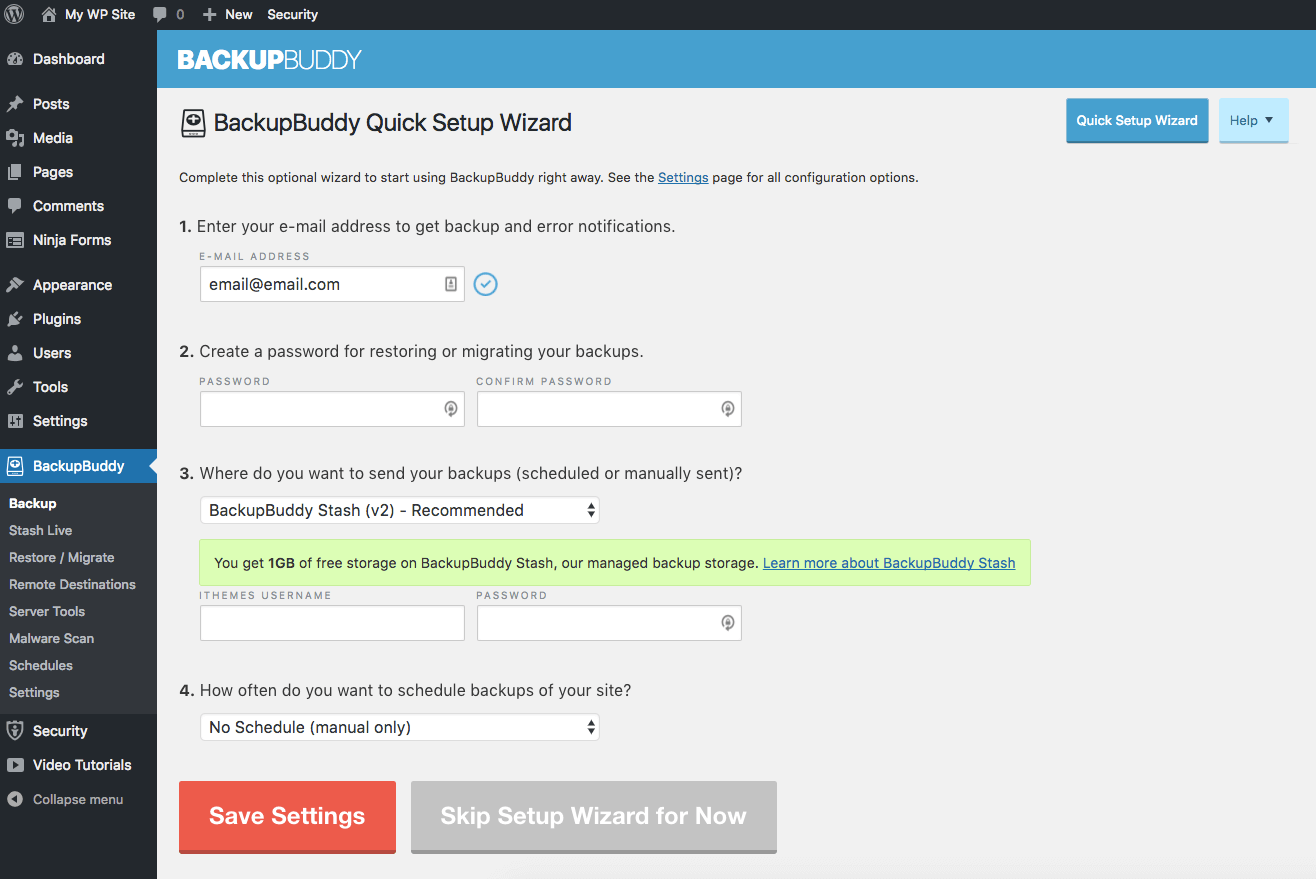
10. BackupBuddy + iThemes Sync Integration
[pullquote]If you’re a BackupBuddy user and you’re not using iThemes Sync, our central dashboard to help you manage multiple WordPress sites, you’re missing out.[/pullquote]
iThemes Sync includes some amazing BackupBuddy & Stash integrations, including the ability to:
- Run remote WordPress backups
- Download your latest backup file remotely
- View number of edits since your last BackupBuddy backup
- Download the ImportBuddy tool to migrate or restore your website
- Add a new BackupBuddy backup schedule
- View, download and delete your BackupBuddy Stash backups
- View a graph of the total amount of Stash space you’ve used
- Install & activate the BackupBuddy plugin on other sites
- License BackupBuddy across all your sites
From the Sync dashboard, click on any site from the Home screen with BackupBuddy installed. Then click the BackupBuddy tab to reveal all the remote BackupBuddy actions.
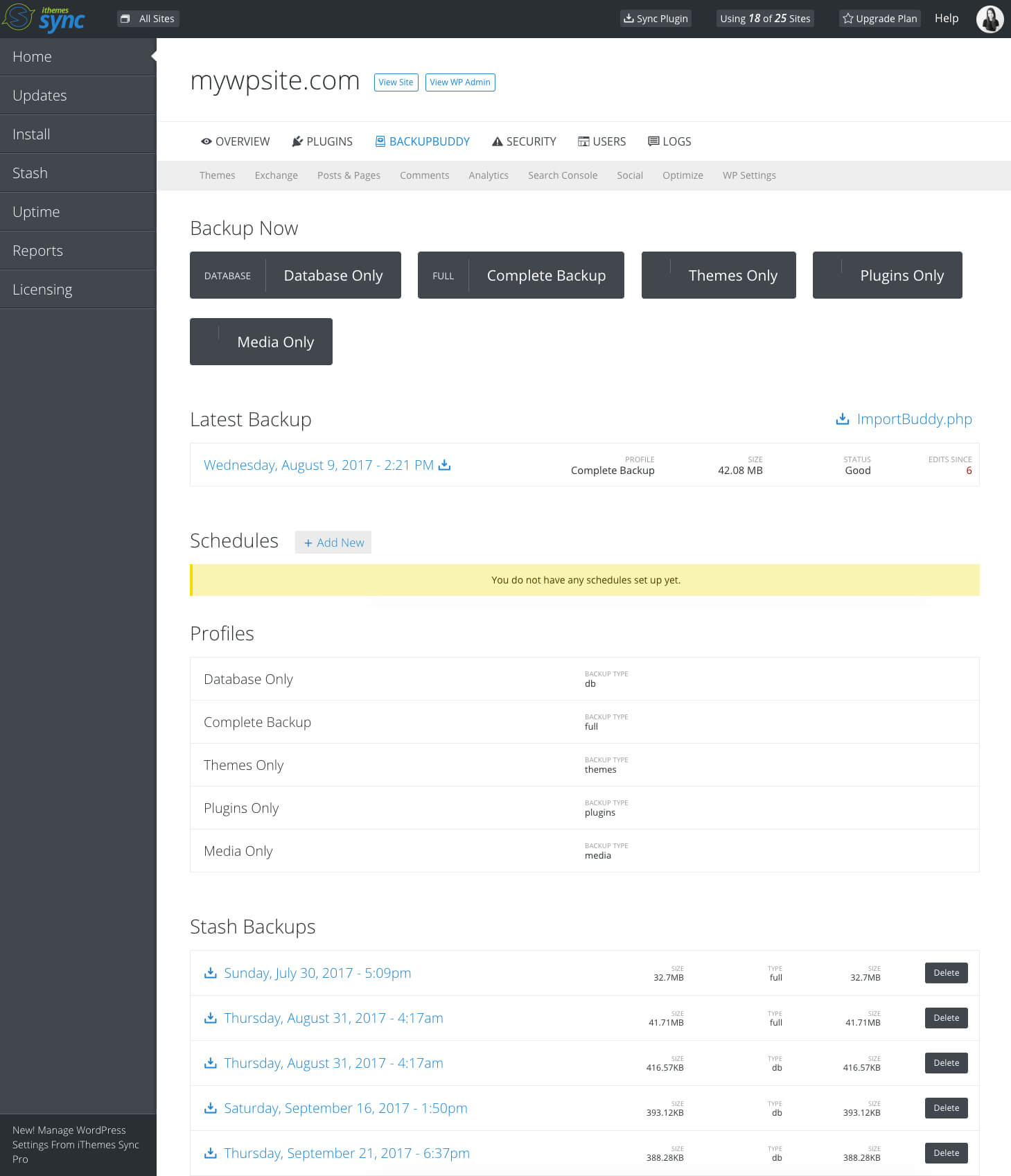
You can also use iThemes Sync to install and activate BackupBuddy across multiple sites at once.
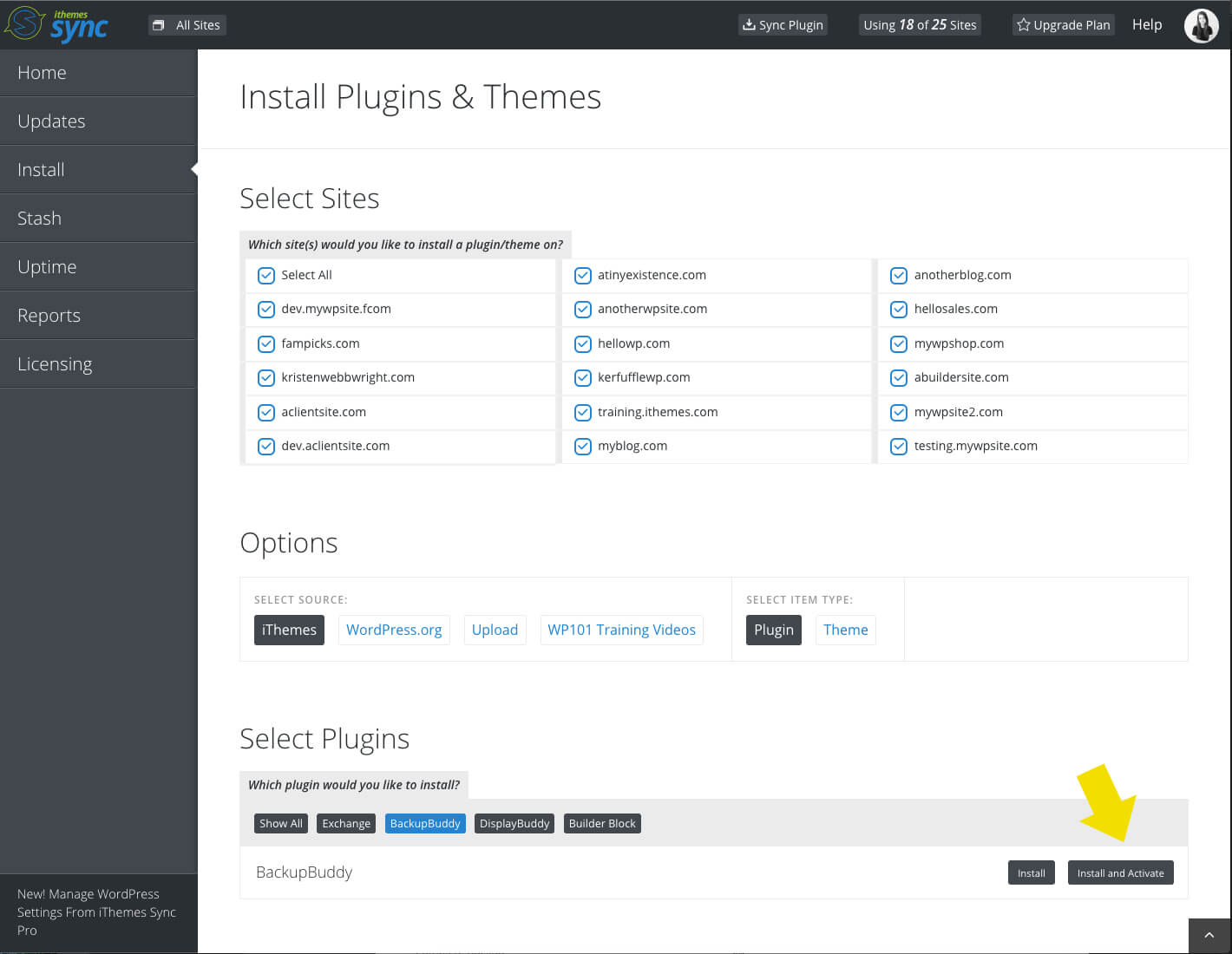
Get BackupBuddy Today
Get the original WordPress backup plugin, BackupBuddy, to start backing up your WordPress site today. With BackupBuddy, you can easily backup, restore or move your WordPress site to a new host or server. You also get automatic WordPress backups with Stash Live, included for free in BackupBuddy.
Get BackupBuddy now
Sign up now — Get SolidWP updates and valuable content straight to your inbox
Sign up
Get started with confidence — risk free, guaranteed
